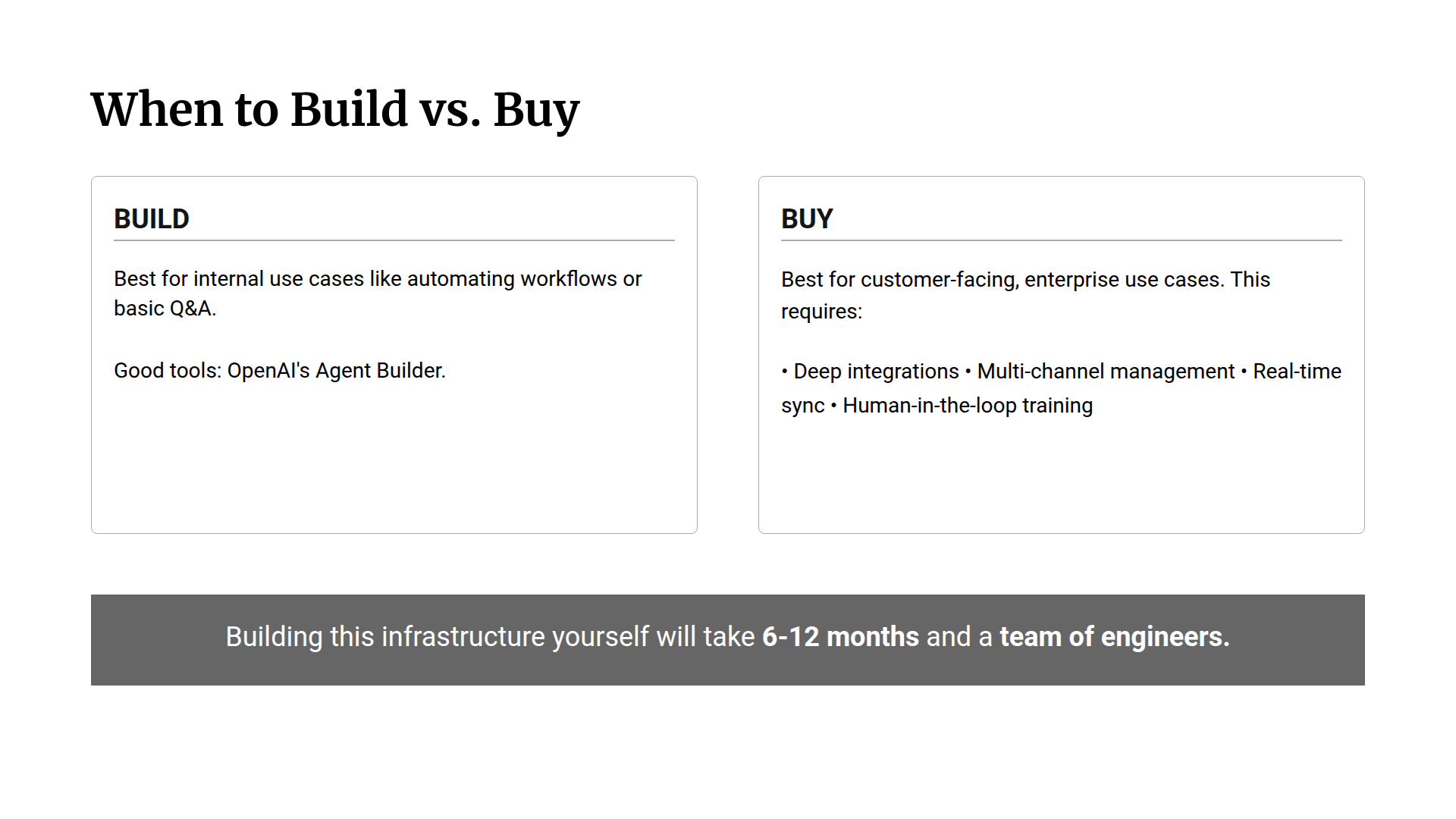The Context Problem: Why 90% of AI Agents Fail (And How We Solved It)

I've debugged over 1,000 failed AI agent implementations in the last 18 months.
Different industries. Different use cases. Different technical stacks.
But they all failed for the same reason: the context problem.
If you've ever tried to build a production-grade AI agent, you know exactly what I'm talking about. If you haven't, this is the post that will save you months of frustration and tens of thousands of dollars in wasted engineering time.
The Problem No One Talks About
Most AI agent tutorials fall into two categories:
Category A: Surface-level demos that don't do much.
These are the "build a customer service chatbot in 30 minutes" tutorials. They look impressive in a demo. They fall apart the moment a customer asks something that wasn't in the training data.
Category B: Hand-wavey explanations that skip the hard parts.
These are the technical deep dives that spend 2,000 words on model selection and prompt engineering, then gloss over the actual hard problem with "and then you just connect it to your data sources."
Both are frustrating. Both lead to founders giving up on AI entirely.
I know because I've been there.
When we started building HostAI (now Conduit) in 2023, I thought the hard part would be getting the AI to sound human. I was managing 26 Airbnbs at the time, drowning in guest messages, and I just wanted something that could handle the repetitive questions.
Turns out, making AI sound human is the easy part.
The hard part is giving it the right context to actually complete tasks.
What Is the Context Problem?
Here's what happens when an AI agent lacks proper context:
A guest messages: "What's the WiFi password?"
Without context:
The agent hallucinates a password, apologizes and says it doesn't know, or pulls the wrong password from a different property.
With context:
The agent knows which property the guest is staying at, retrieves the correct WiFi credentials from the property database, and responds instantly with the right information.
Seems simple, right?
Now multiply that by 100 different types of questions across 350 properties with different check-in procedures, house rules, amenity details, and local recommendations.
Suddenly, you're not building a chatbot. You're building a knowledge orchestration system.
The Three Dimensions of Context
Most founders think context is just "connecting the AI to a database."
That's like saying building a car is just "connecting the wheels to an engine."
Real context has three dimensions, and you need all three working together:
1. Business Context
This is your company's operational knowledge:
- Property details (WiFi passwords, check-in codes, amenities)
- Business rules (cancellation policies, upsell guidelines, escalation triggers)
- Standard operating procedures (how to handle maintenance requests, when to involve humans)
The challenge: This information lives in multiple places. Your PMS. Your internal docs. Your team's heads. Most of it has never been written down in a structured format.
2. Customer Context
This is the specific information about the person you're communicating with:
- Which property are they staying at?
- When is their check-in date?
- What have they already asked about?
- Are they a first-time guest or a returning customer?
- What's the sentiment of this conversation?
The challenge: This context changes in real-time. A guest books today, checks in tomorrow, and has a maintenance issue next week. Your AI needs to understand where they are in that journey at every moment.
3. Conversation Context
This is the flow of the current interaction:
- What has already been discussed in this conversation?
- What questions have been answered?
- What's the user's current intent?
- Should this be escalated to a human?
The challenge: Conversations are non-linear. A guest might ask about check-in, then jump to asking about parking, then circle back to check-in with a follow-up question. Your AI needs to maintain coherent context across that entire thread.
When all three dimensions are working together, the AI feels intelligent and helpful.
When even one dimension is broken, the AI feels frustrating and useless.
Why Most Platforms Get This Wrong
I speak to a lot of $1M+ ARR business owners who are stuck with AI agents that don't work.
They've spent months building. They've hired consultants. They've tried multiple platforms.
And they still can't get their agents to handle real customer conversations reliably.
The problem is that most platforms treat context as an afterthought.
They give you a powerful language model and some basic tools to connect to your data. Then they expect you to figure out the orchestration yourself.
Here's what that actually means:
You have to build the data pipelines. How do you get property information from your PMS into a format the AI can use? How do you keep it in sync when things change?
You have to build the routing logic. How does the AI know which property a guest is asking about? How do you handle multi-property conversations?
You have to build the escalation system. How do you detect when the AI is about to make a mistake? How do you hand off to a human smoothly?
You have to build the training loop. How do you capture feedback from humans? How do you improve the AI over time?
Unless you're obsessed with debugging integration errors and have a team of engineers with six months to spare, you're going to struggle.
How We Solved It at Conduit
When we started Conduit, we made a different architectural choice.
We decided to build the platform we wished existed when we were struggling with these problems.
That meant solving the context problem at the infrastructure level, not pushing it onto customers.
Here's how we did it:
The Omnichannel Inbox
Every conversation flows through a single unified interface, regardless of whether it came from SMS, email, Airbnb, WhatsApp, or a phone call.
This solves the conversation context problem. The AI (and your team) can see the full history of every interaction with a customer across every channel.
When a guest texts you after emailing you yesterday, the AI knows. It doesn't ask them to repeat themselves.
Automated CRM Data Modeling
We automatically sync with your property management system, extract the relevant context, and structure it in a way that AI can use reliably.
This solves the business context problem. You're not manually uploading property details or writing complex data transformation scripts. The AI has access to your property information, guest reservations, and business rules automatically.
When Pass the Keys integrated Conduit with their proprietary PMS "Connect," they were able to spin up 60+ franchise workspaces, each with perfect context isolation. One franchise can't see another's data, but each AI agent has complete access to everything it needs for its own properties.
The Human-in-the-Loop Training System
This is the piece most platforms miss entirely.
Your team works alongside the AI in the same inbox. When the AI handles something correctly, it happens automatically. When something requires human judgment, it escalates smoothly.
But here's the key: every human interaction trains the AI to get better.
Your team isn't just handling escalations. They're building the knowledge base that makes future conversations fully automated.
This solves the customer context problem. The AI learns your specific guests, your unique edge cases, and your brand voice over time.
The Architecture That Makes It Work
If you're building AI agents for your own business, here's what you need:
1. A Single Source of Truth for Conversations
Stop trying to build AI that lives in multiple places. Pick one platform where all conversations happen, and build your AI there.
At Conduit, that's our unified inbox. It connects to every channel, but there's only one place where context is stored and accessed.
2. Real-Time Sync with Your Systems of Record
Your AI needs to pull fresh data from your PMS, CRM, or booking system in real-time. Stale data is almost worse than no data—it makes the AI confidently wrong.
We built direct integrations with major property management systems. When a reservation changes, the AI knows immediately.
3. Multi-Model Intelligence
We use multiple different models (OpenAI, Anthropic, Google) depending on the task. This means we're always benefiting from the latest breakthroughs from the labs.
When OpenAI just dropped Agent Builder, people texted me asking if it was a threat to Conduit.
My answer: We pay more attention to model announcements than product announcements. Better models make our platform better automatically.
4. Clear Escalation Boundaries
Your AI should know what it doesn't know. Set clear rules for when to escalate to a human, and make that handoff seamless.
At Conduit, escalations appear in the same inbox where your team is already working. There's no separate "AI dashboard" to check. It's just another conversation that needs attention.
A Real-World Example
Let me show you what this looks like in practice.
City Superhost in the UK uses Conduit integrated with SuiteOp. They've built a workflow that proactively reaches out to guests who had less than a five-star check-in experience.
Here's how the context flows:
1. Business Context: SuiteOp tracks check-in feedback scores. When a score is below 5 stars, it triggers a webhook to Conduit.
2. Customer Context: Conduit knows which guest, which property, what went wrong (pulled from SuiteOp), and the conversation history.
3. Conversation Context: The AI reaches out proactively, acknowledges the issue, collects feedback, and offers a solution—all while maintaining a empathetic, human tone.
If the issue requires immediate action (like a broken appliance), it escalates to the human team with all the context they need.
The result: They're able to recover five-star experiences in real-time and prevent negative reviews before they happen.
That's only possible because all three dimensions of context are working together.
The Red Flags Your Context Architecture Is Broken
If you're building AI agents and hitting these issues, your context architecture needs work:
Red Flag #1: "The AI gives different answers to the same question."
This means your business context is inconsistent. The AI is pulling from multiple sources that contradict each other.
Red Flag #2: "The AI can't remember what was said earlier in the conversation."
This means your conversation context isn't being maintained properly. You probably don't have a unified conversation thread.
Red Flag #3: "The AI gives correct information, but for the wrong property."
This means your customer context routing is broken. The AI can't reliably identify which specific property a guest is asking about.
Red Flag #4: "The AI hallucinates information when it's not sure."
This means you haven't set clear boundaries for what the AI knows vs. doesn't know. You need better escalation rules.
Red Flag #5: "It takes weeks to add new properties or update information."
This means your data modeling is manual and fragile. You need automated sync with your systems of record.
When to Build vs. Buy
Here's my honest take:
If you're building AI agents for internal use—automating workflows, summarizing documents, basic Q&A—OpenAI's Agent Builder or similar tools are great. The context requirements are simpler because you control the environment.
But if you're building customer-facing agents for enterprise use cases, you need more.
You need:
- Deep integration with your systems of record
- Multi-channel conversation management
- Real-time context synchronization
- Human-in-the-loop training
- Complete visibility into what your agents are doing
Building that infrastructure yourself will take 6-12 months and a team of engineers.
We built Conduit because we needed that infrastructure, and it didn't exist.

The Future of Conversational AI
Here's what I believe:
Every business will eventually use AI agents to handle most conversations.
Not because AI is cheaper than humans (though it is).
But because conversations are where business actually happens.
A hotel upselling a spa package. A property manager scheduling maintenance. A leasing agent closing a rental.
These aren't side tasks. They're how revenue is captured and customers are retained.
The global service labor market is trillions of dollars, and most of it flows through conversations.
The companies that win will be the ones that solve the context problem.
Not just connecting an AI to a database.
But building the infrastructure that lets AI and humans work together seamlessly, with complete context, across every channel.
That's what we're building at Conduit.
If you're building AI agents for your business and hitting the context problem, I'd love to hear about it. What's the hardest part for you? Reply in the comments or DM me—I read every message.
_.png)


